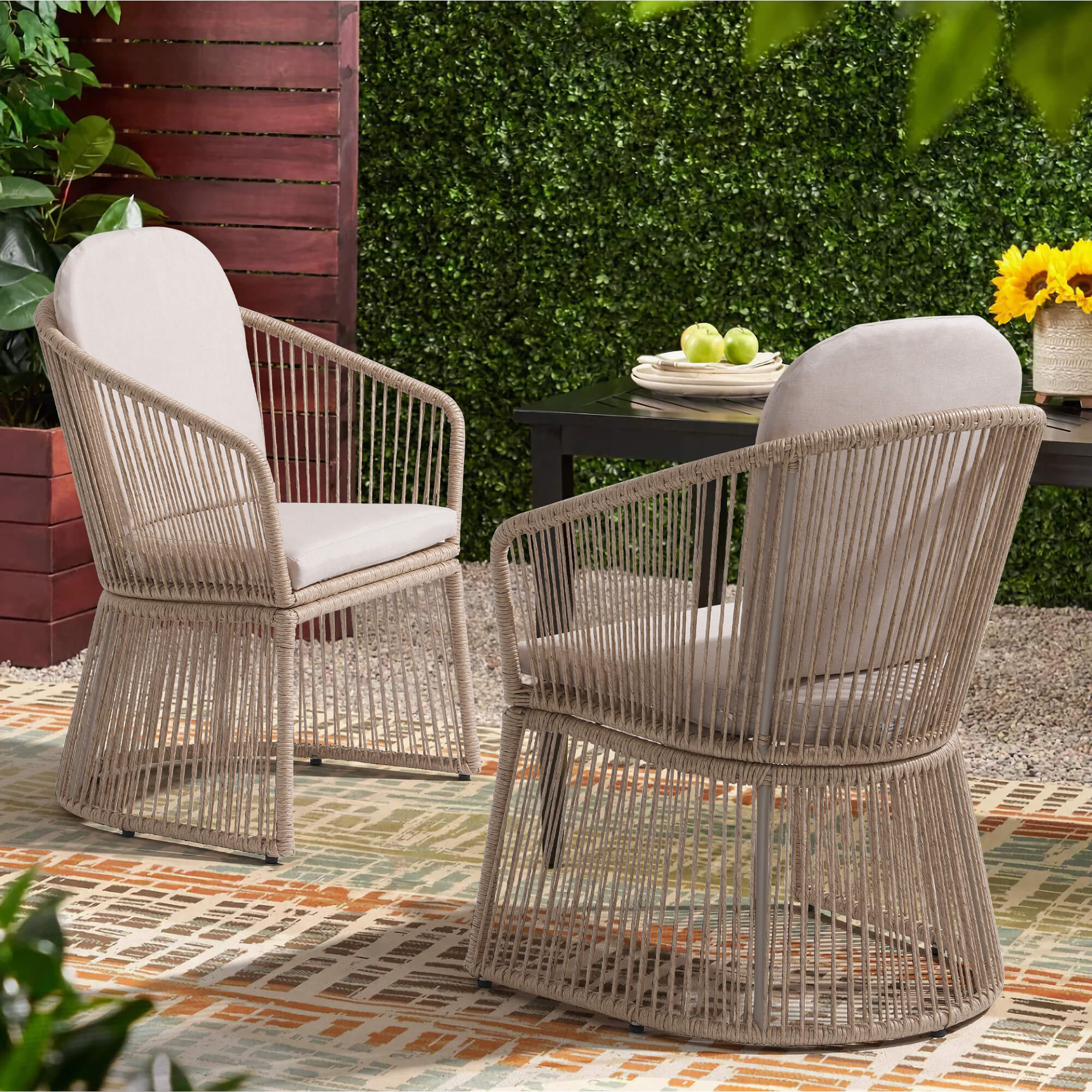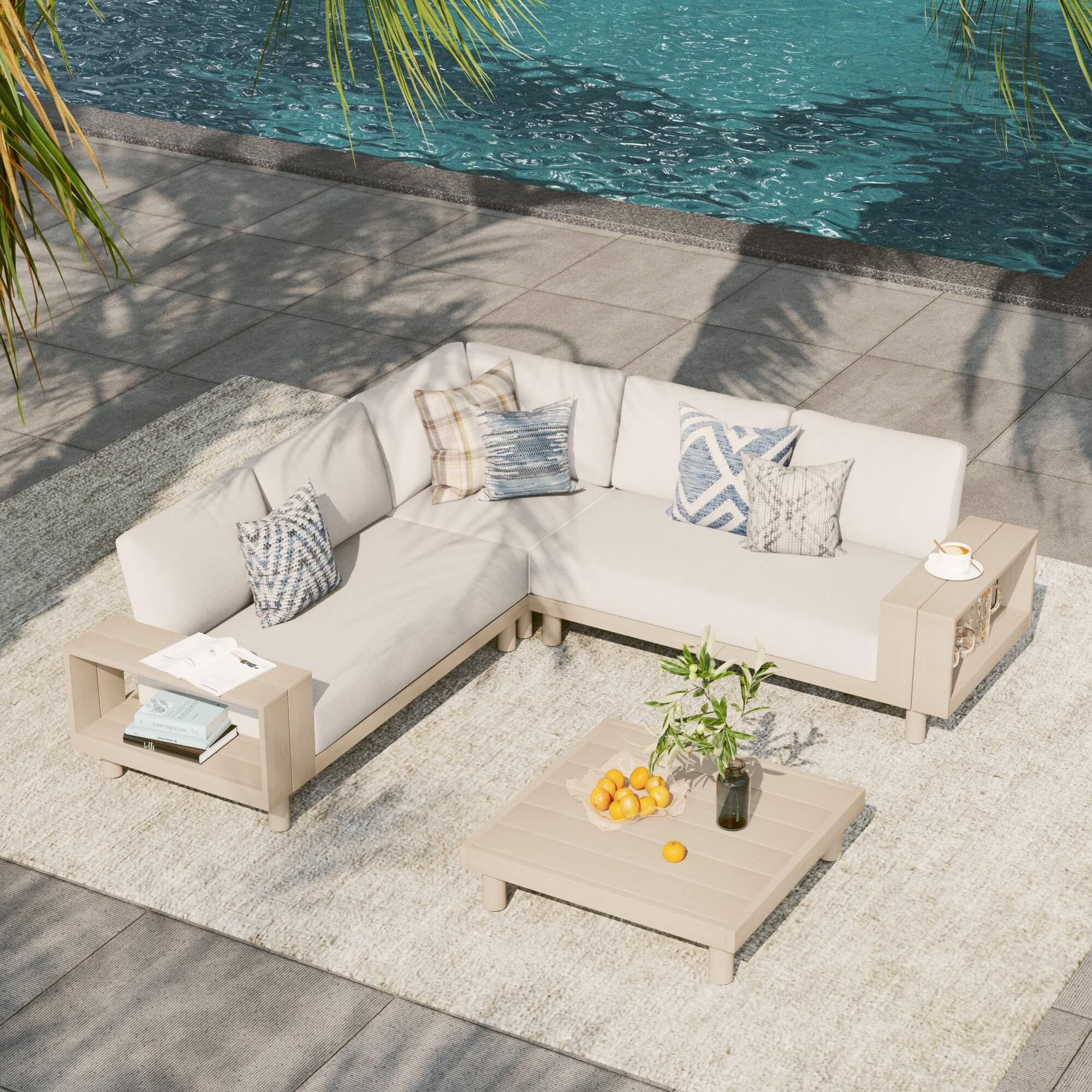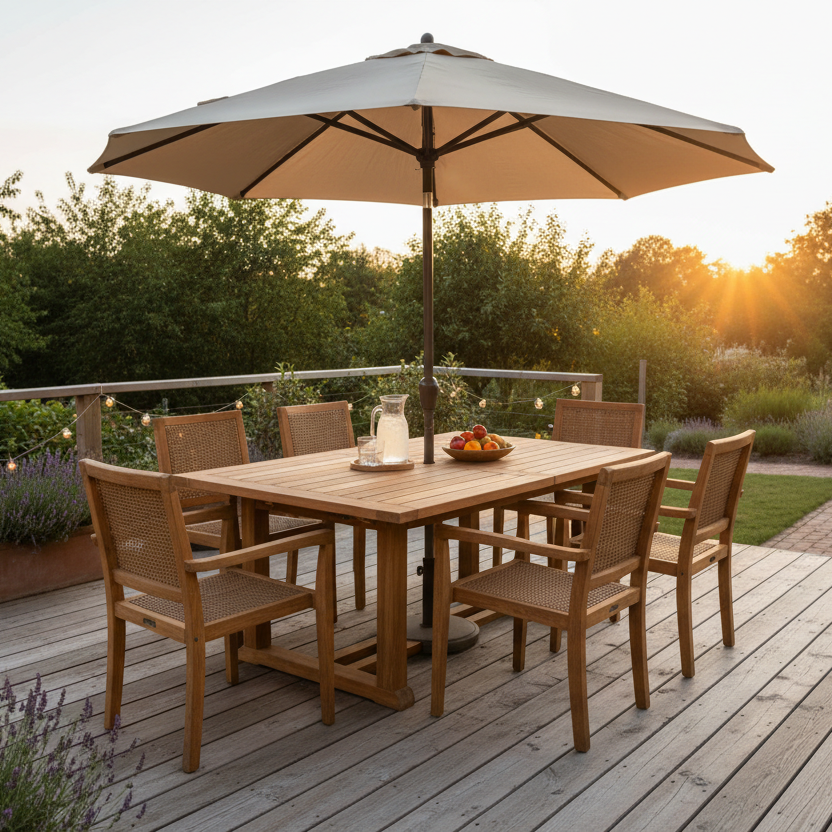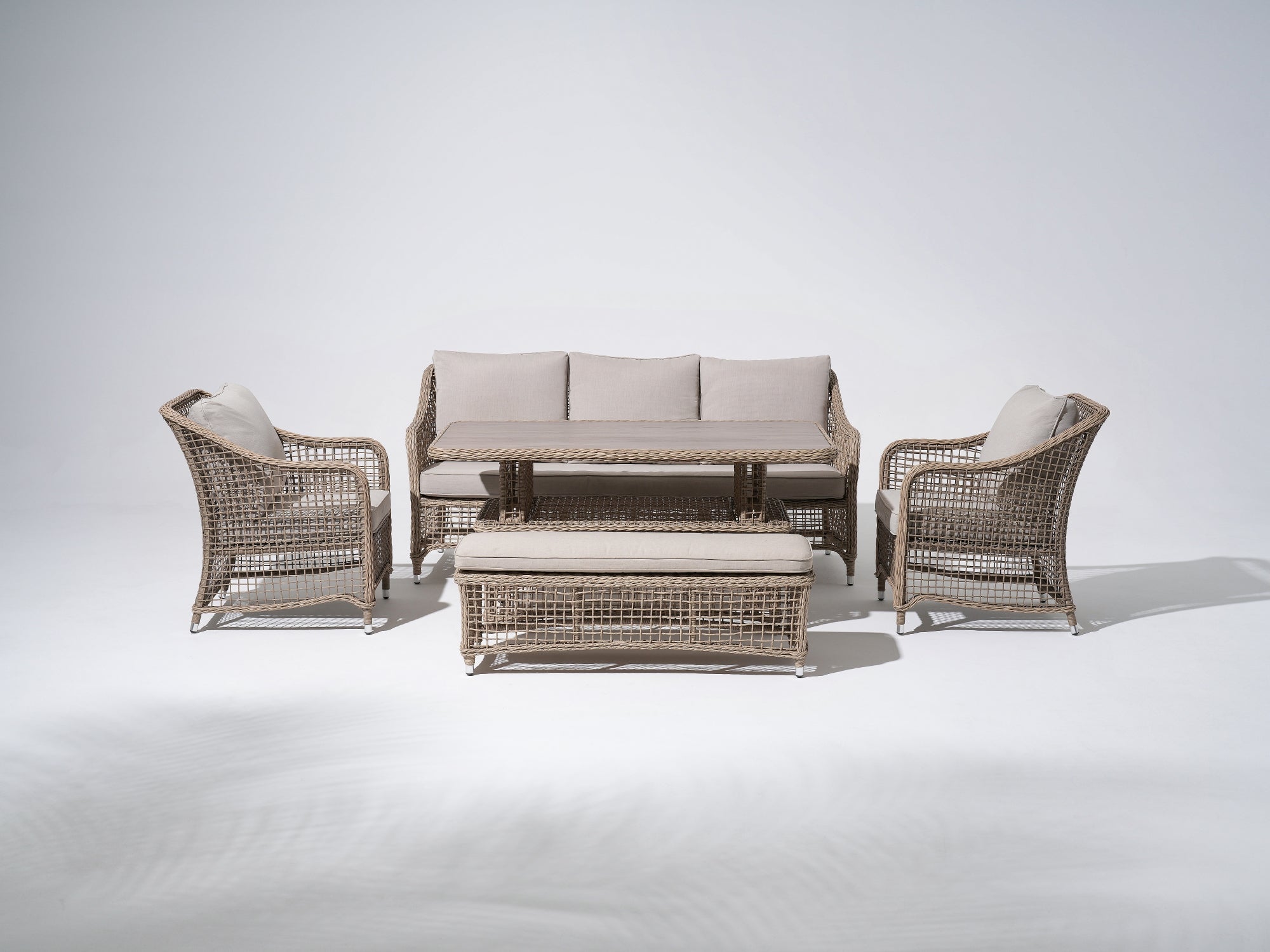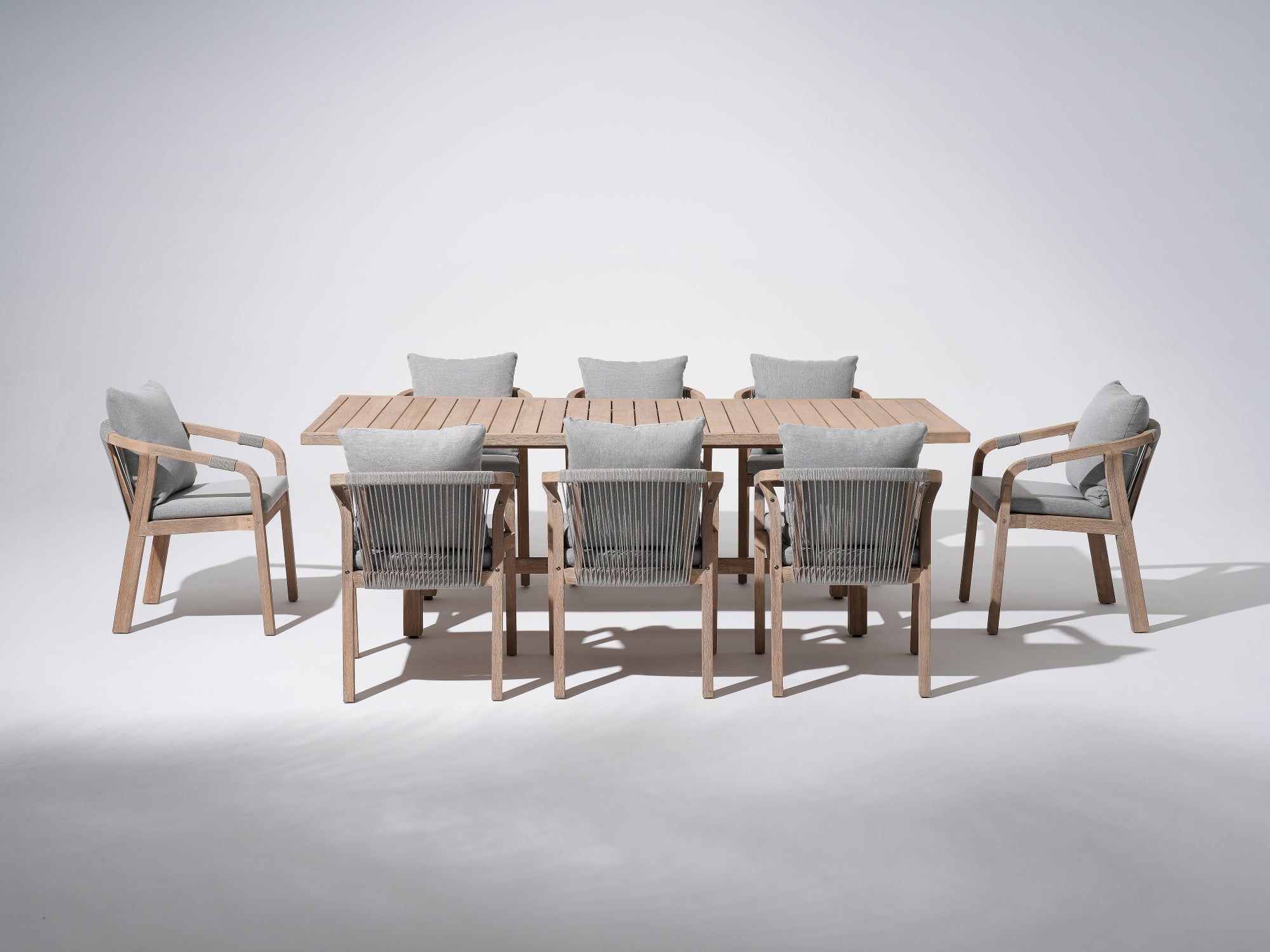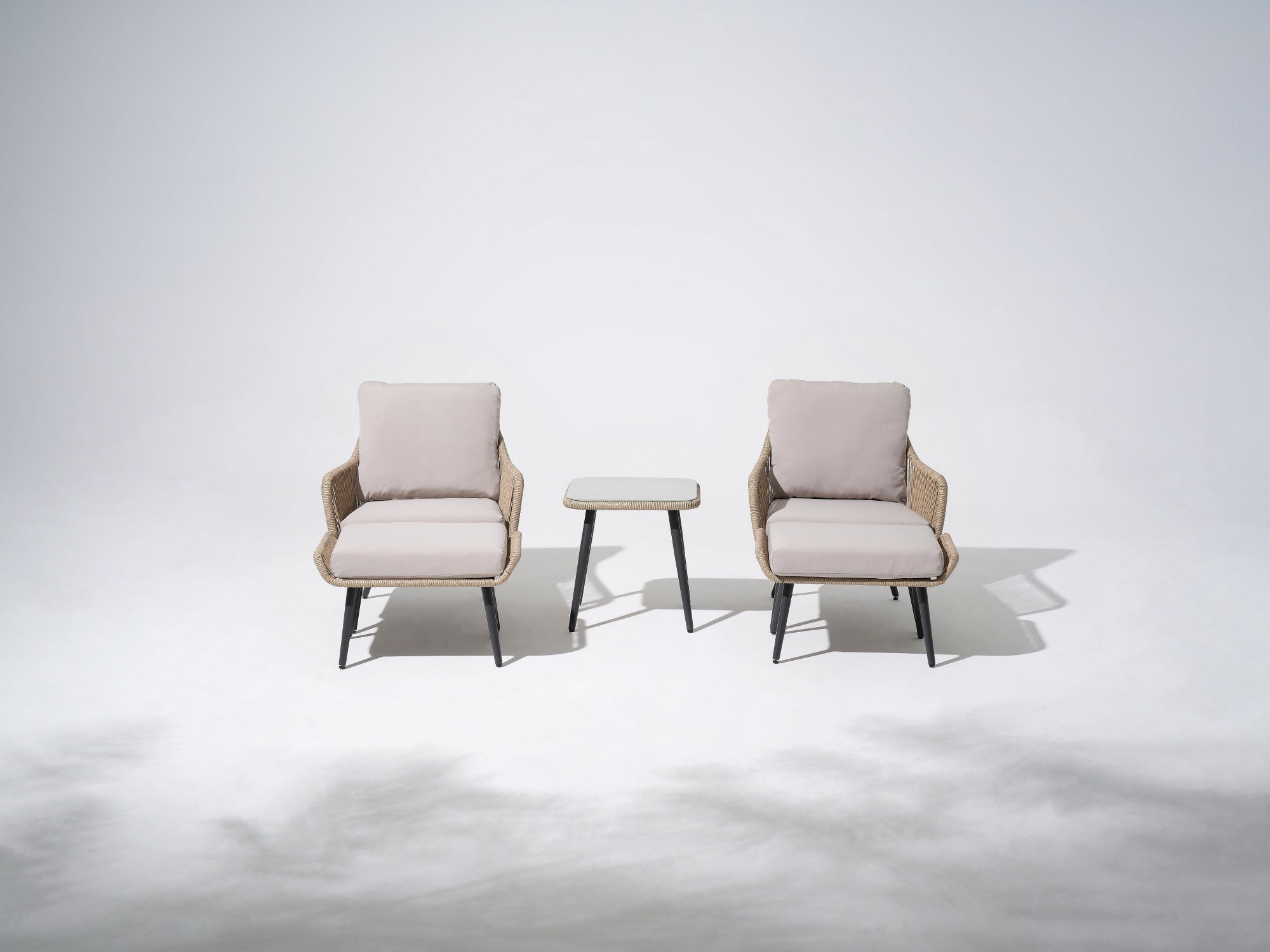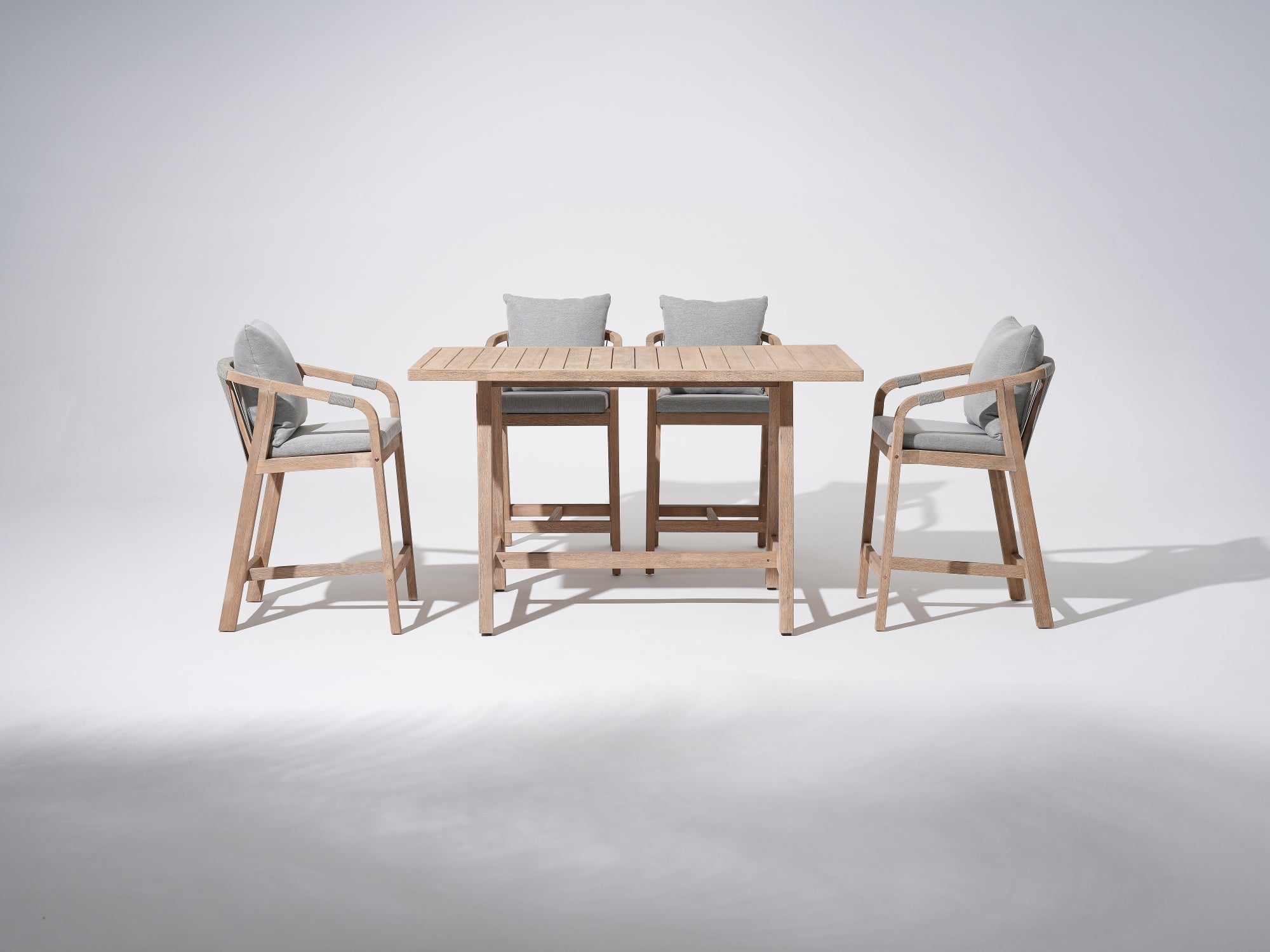When it comes to purchasing wooden outdoor furniture, the two most common materials are undoubtedly Acacia wood and Teak wood. But which one is better? Both have their unique characteristics, and understanding their differences can help you make a smart decision that aligns with your needs, budget, and aesthetic preferences. Let’s take a closer look at these two types of wood.
| Feature |
Acacia Wood |
Teak Wood |
| Hardness |
Harder (1,700–2,200 Janka) |
Medium-hard (1,000–1,400 Janka) |
| Natural Durability |
Good resistance to weather/water |
Excellent (high natural oil content) |
| Maintenance |
Needs sealing/staining regularly |
Low maintenance (can weather to silver-gray) |
| Cost |
More affordable |
More expensive (premium hardwood) |
| Sustainability |
Fast-growing (often sustainable) |
Slow-growing (seek FSC-certified for sustainability) |
| Appearance |
Rich, warm tones; varied grain patterns |
Golden-brown tone; smooth, straight grain |

Also known as Acacia (not to be confused with unrelated tree species), acacia is a versatile tree commonly used in outdoor furniture. Native to regions including southern China and Southeast Asia, it is a tall evergreen tree that typically grows 20–30 meters high, occasionally reaching 40 meters. Its smooth gray bark features prominent vertical cracks, and the heartwood ranges from pale white to light brown, often with subtle natural streaks.
Acacia wood is celebrated for its hardness and durability, making it resistant to rot, insects, and decay—key traits that explain its widespread use in outdoor tables, chairs, and fixtures. It emits a faint, natural aroma similar to phoebe wood, which acts as a natural insect repellent. This makes acacia ideal for storing clothing, books, and artworks; historically, it was favored by royal families for crafting bookcases and cabinets. Additionally, acacia offers exceptional thermal stability: it remains cool in summer and warm in winter, a unique comfort feature not common in other hardwoods. Its dense grain and low moisture expansion coefficient reduce warping or cracking, ensuring long-lasting outdoor performance.
Culturally, acacia holds deep symbolism in Chinese tradition as a symbol of love. Its seeds, known as "red beans" (hongdou), are iconic emblems of romantic longing, inspired by legends that planting acacia seeds fosters love stories. This cultural significance adds emotional depth to its practical uses.
Types of Acacia Wood
Acacia is a diverse genus with over 1,300 species, but the most commonly used types for furniture and outdoor applications include:
-
Acacia Mangium – Fast-growing, moderately durable, often used for indoor furniture.
-
Acacia Auriculiformis – Hard and dense, suitable for flooring and cabinetry.
-
Black Acacia (Acacia Melanoxylon) – High durability, used for fine woodworking and outdoor furniture.
-
Australian Blackwood (Acacia spp.) – Premium quality, prized for its rich grain and stability.
How to Identify High-Quality Acacia Wood
-
Grain & Color – High-grade acacia has a tight, consistent grain with rich color variations (golden brown to deep reddish tones). Avoid wood with uneven discoloration.
-
Density & Hardness – Denser wood (Janka hardness >1,700 lbf) is more durable. Knock test: A solid, resonant sound indicates good quality.
-
Moisture Content – Properly kiln-dried wood (8-12% moisture) resists warping. Check for cracks or excessive shrinkage.
-
Knots & Defects – Minimal knots and smooth surfaces suggest better quality. Large cracks or loose knots weaken the wood.
-
Finish & Treatment – High-quality acacia is sanded smoothly and treated with UV/oil finishes for outdoor use.

Belonging to the Tectona grandis species in the Lamiaceae family, teak is native to South Asia (India, Myanmar, Thailand) and renowned for its rugged, coarse grain pattern. As a heavy-duty hardwood, it is defined by high density and minimal shrinkage/swelling in response to humidity, making it exceptionally stable and resistant to deformation or splitting.
Teak’s natural oil content is its defining feature, providing inherent resistance to water, rot, and pests without frequent treatment. This makes it a top choice for outdoor furniture in harsh weather, from tropical rains to intense sunlight. The wood’s golden-brown hue darkens gracefully to a silvery patina if untreated, or maintains its rich color with regular sealing. Historically, teak has been prized for shipbuilding and architecture due to its longevity; even buried in soil, it remains intact for decades, a testament to its durability.
While teak lacks acacia’s aromatic properties, its combination of strength, weather resistance, and timeless aesthetic has made it a premium choice in traditional and modern outdoor designs.
Types of Teak Wood
Teak wood (Tectona grandis) is highly valued for its durability, water resistance, and aesthetic appeal. It comes in different grades and types based on origin, age, and quality. Here’s a breakdown:
Burmese Teak (Myanmar Teak) – Considered the highest quality due to tight grain, high natural oil content, and golden-brown color.
-
Indian Teak – Grown in India, slightly lighter in color but still durable.
-
African Teak (Iroko or "False Teak") – Often called "African Teak" but is actually Milicia excelsa; resembles teak but is less oily.
-
Plantation Teak (Indonesian, South American, or Costa Rican Teak) – Younger trees with less natural oil, lighter color, and less durability than old-growth teak.
-
Thai Teak – Similar to Burmese teak but now rare due to logging restrictions.
How to Identify Genuine Teak Wood
1. Color & Grain:
Fresh teak has a golden-brown hue, aging to silvery-gray if untreated.
Tight, straight grain with occasional wavy patterns.
2. Texture & Weight:
Smooth, oily feel due to natural oils (tectoquinones).
Heavy and dense compared to fake teak (like rubberwood or treated pine).
3. Scent:
Freshly cut teak has a leather-like or earthy smell.
4. Water Resistance:
Genuine teak repels water and resists warping.
5. Price & Source:
Authentic Burmese or old-growth teak is expensive; cheap "teak" is likely plantation-grown or a substitute.
Fake Teak vs. Real Teak
-
Imitations: Rubberwood, Shorea (Balau), or stained pine may be sold as "teak."
-
Oil Test: Real teak retains oiliness even when dry.
-
Durability Test: Genuine teak resists decay and termites naturally.
In terms of hardness, acacia wood has a coefficient ranging from 700 to 1100 on common hardness scales, such as the Janka hardness test. This classifies it as a moderately hard hardwood, offering adequate resistance to daily wear and tear. While acacia can endure regular outdoor use, its relatively lower hardness makes it more prone to minor dents, scratches, or surface marks when faced with heavy impacts or abrasive elements. Nevertheless, its density and interlocking grain structure contribute to its overall durability, enabling it to retain structural stability over time. As such, acacia serves as a practical option for outdoor furniture, striking a balance between cost, aesthetic appeal, and reasonable longevity.
Teak wood significantly surpasses acacia in hardness, boasting a coefficient between 1000 and 1600 on the Janka hardness scale. This elevated hardness imparts teak with outstanding compressive, flexural, and abrasion-resistant properties. The wood's higher density and natural oil content enhance its capacity to withstand deformation under pressure, bending forces, and friction caused by frequent use or environmental exposure. Consequently, teak furniture is less likely to develop deep scratches, cracks, or surface damage, even in high-traffic outdoor environments or with rough handling. Its superior hardness cements teak's status as an ideal material for outdoor applications requiring enduring strength and resilience, justifying its reputation as a premium choice for top-quality outdoor furnishings.

Both acacia and teak exhibit excellent resistance to decay in outdoor settings, but acacia's performance over time has its limitations. While acacia wood possesses natural properties that offer initial protection against rot and insects, its weather resistance tends to decline gradually with prolonged exposure to the elements. Without regular maintenance, such as sealing and staining, acacia can be more vulnerable to moisture absorption, which may lead to warping, cracking, or discoloration. Additionally, its lower natural oil content compared to teak means it lacks the same level of inherent defense against mold, mildew, and insect infestations. As a result, the lifespan of acacia outdoor furniture is generally shorter, typically ranging from 5 to 10 years depending on usage and environmental conditions.
Teak wood stands out for its exceptional durability in outdoor environments, primarily due to its rich natural oil content. These oils act as a built-in waterproofing agent, creating a barrier that prevents moisture penetration and subsequent issues like swelling or splitting. Moreover, teak's oils possess inherent anti-fungal and insect-repellent properties, effectively guarding against mold, mildew, and wood-boring pests without the need for frequent chemical treatments. This innate resistance allows teak furniture to maintain its structural integrity and aesthetic appeal even when exposed to extreme weather conditions, from scorching sun to heavy rain and freezing temperatures. With minimal maintenance, teak can last upwards of 20 years or more, making it a long-term investment for outdoor spaces. Its superior durability, combined with its ability to age gracefully into a beautiful silver-gray patina, cements teak's position as the top choice for those seeking furniture with lasting performance.
The price disparity between acacia wood and teak wood is significant, primarily driven by their availability, durability, and market demand.
Acacia Wood generally costs 500-1500 per cubic meter (for commercial-grade lumber), making it a mid-range option. This is due to its relatively fast growth rate and widespread cultivation in regions like Southeast Asia and Africa, which ensures a steady supply. While acacia is valued for its attractive grain and moderate strength, it lacks the natural oils and density that make teak highly resistant to decay and insects, limiting its use in high-end applications.
-
Outdoor Furniture Example: A standard acacia wood patio sofa set (including a 3-seater, two chairs, and a coffee table) typically ranges from $800-$2500, depending on craftsmanship and design.
Teak Wood, on the other hand, commands a premium price of 1500-5000 per cubic meter (with premium old-growth teak reaching even higher), positioning it as a luxury material. Teak’s slow growth, scarcity (especially of naturally sourced, mature trees), and exceptional durability—thanks to its high oil content and tight grain—drive its cost. It is highly sought after for outdoor furniture, marine applications, and upscale interior design, where its resistance to weathering and low maintenance requirements justify the expense.
-
Outdoor Furniture Example: A comparable teak wood patio sofa set (similar configuration) can cost $3000-$10000+, making it 3–5 times more expensive than acacia wood furniture.
The limited supply of sustainably harvested teak, coupled with strict logging regulations in many countries, further elevates its market value compared to more abundant woods like acacia. While acacia offers a budget-friendly alternative, teak remains the superior choice for long-term outdoor use, justifying its higher price.
While acacia and teak are popular choices for
outdoor furniture, acacia undoubtedly wins in terms of cost-effectiveness for those seeking value for money, while teak is the go-to option for those with a generous budget. There are also other durable hardwoods worth considering, such as eucalyptus and oak, which make excellent alternatives.
Eucalyptus wood has gained attention for its natural resistance to decay and pests, positioning it as a sustainable substitute for traditional teak. Its tight grain structure and rich reddish-brown hue develop a beautiful silvery patina as it weathers, adding both durability and aesthetic appeal to outdoor spaces. Oak, another robust choice, offers strong structural stability and a classic texture, making it suitable for a variety of outdoor furniture styles while balancing performance and cost. Want to learn more about how eucalyptus compares? Check out our detailed guide:
Is Eucalyptus Wood Good for Outdoor Furniture?








